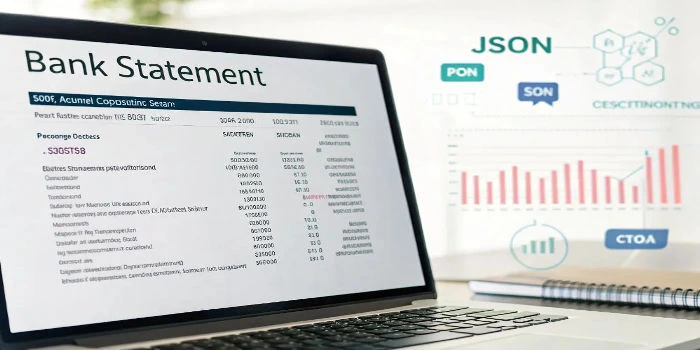20-22 Wenlock Road, LONDON, N1 7GU
20-22 Wenlock Road, LONDON, N1 7GU

In an era where financial data needs to be fast, flexible, and highly integrable, converting bank and credit card statements into JSON has become essential for developers, accountants, business analysts, and fintech startups. JSON (JavaScript Object Notation) offers a lightweight and structured format that machines and applications love.
In this guide, we’ll explore how to convert bank statements to JSON using AI-driven platforms.
Bank statements are traditionally available in PDF, Excel, or CSV formats. However, these aren’t ideal when it comes to:
JSON offers a solution that’s both machine-readable and developer-friendly.
You can convert bank statements to JSON in three major ways:
These are the easiest options for non-developers or quick one-time tasks.
Caelum AI offers a document parsing solution that uses AI/ML to extract data from bank or credit card statements and convert it into a structured JSON format.
Key Features:
If you’re a developer or want to automate the process, coding gives you the most control.
Using pandas to read CSV and convert it into JSON:
import pandas as pd
# Load CSV
df = pd.read_csv('bank_statement.csv')
# Convert to JSON
json_output = df.to_json(orient='records')
# Save the JSON
with open('output.json', 'w') as file:
file.write(json_output)
print("Bank statement successfully converted to JSON.")Libraries Required:
pip install pandasFor JavaScript developers:
const fs = require('fs');
const csv = require('csv-parser');
const results = [];
fs.createReadStream('bank_statement.csv')
.pipe(csv())
.on('data', (data) => results.push(data))
.on('end', () => {
fs.writeFileSync('output.json', JSON.stringify(results, null, 2));
console.log("JSON saved successfully.");
});Install dependencies:
npm install csv-parserIf you’re managing high volumes of bank data or need real-time processing, combining AI tools like Caelum AI with API-based coding ensures speed, accuracy, and flexibility.
Example Workflow:
Credit card statements often have a more detailed and varied structure than regular bank statements. They include:
Why JSON Matters for Credit Cards:
Tools are especially helpful in parsing credit card statements with non-standard formats and turning them into usable JSON data.
Sample JSON Output from a Credit Card Statement:
[
{
"Date": "2025-03-02",
"Merchant": "Uber Eats",
"Category": "Food Delivery",
"Amount": -23.99,
"Currency": "USD"
},
{
"Date": "2025-03-05",
"Merchant": "Amazon",
"Category": "Shopping",
"Amount": -150.00,
"Currency": "USD"
}
]Converting bank statements to JSON doesn’t have to be complicated. Whether you’re a non-technical user looking for a quick software solution or a developer automating the pipeline with code, there are multiple reliable paths.
Whether you’re feeding data into your accounting software, building a fintech app, or running reports, JSON makes financial data easier to manage and automate.
Caelum AI is ideal for this task, using AI/ML to extract data from PDFs and export it as JSON, even from scanned documents.
Yes, using OCR tools like Caelum AI, you can extract data and convert it into JSON.
CSV is the easiest to convert, followed by Excel. PDFs require OCR or advanced parsing tools for structured extraction.
Be cautious, Use trusted, secure platforms and avoid uploading sensitive data to unknown sites without encryption or data policies.
Yes! Use a combination of API and Python/Node.js scripts to automate bulk conversions with secure workflows.